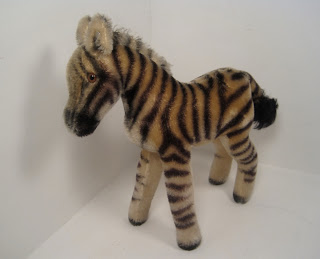Steiffgal thought it was time to take a walk on the wild side and look at one of Steiff's more exotic wild animals - zebras! These striped sweethearts have been gracing the Steiff catalog since 1899 when the first ones appeared in felt and on wheels. They have had an almost continuous presence in the line since then. Let's "line up" a few of the more interesting and beloved post WWII models -one in wool plush, one in mohair, and one in velvet - and see what makes them so interesting from a design evolution and collector's perspective.
 Wool plush: Steiffgal could hardly believe her eyes when this first zebra example arrived at her home a month or so ago. Do you know the feeling when something is actually better than you expected? That's what happened with this black and white buddy. Here we have Steiff's very early post war wool plush zebra. He has a sweet, innocent, "old fashioned" look about him. He is 22 cm, standing, unjointed, and made from wool plush that has been hand painted with black stripes. He has unusual grey and black pupil eyes (which Steiffgal suspects have faded over time) and his US zone tag. Most wonderfully, he has a blank steel button, the one that was only used for a handful of years when the factory reopened for business after the war in the late 1940's. Items with this button are quite rare and very exciting from a collector's perspective. A close up of his blank button is shown here on the left. Overall, this zebra was produced in 22 and 28 cm from 1949 through 1951; the exact same pattern was made in silk plush in 22 cm in 1948.
Wool plush: Steiffgal could hardly believe her eyes when this first zebra example arrived at her home a month or so ago. Do you know the feeling when something is actually better than you expected? That's what happened with this black and white buddy. Here we have Steiff's very early post war wool plush zebra. He has a sweet, innocent, "old fashioned" look about him. He is 22 cm, standing, unjointed, and made from wool plush that has been hand painted with black stripes. He has unusual grey and black pupil eyes (which Steiffgal suspects have faded over time) and his US zone tag. Most wonderfully, he has a blank steel button, the one that was only used for a handful of years when the factory reopened for business after the war in the late 1940's. Items with this button are quite rare and very exciting from a collector's perspective. A close up of his blank button is shown here on the left. Overall, this zebra was produced in 22 and 28 cm from 1949 through 1951; the exact same pattern was made in silk plush in 22 cm in 1948. Mohair: Mohair has been an important fabric in the Steiff line since the early 19-teens. Mohair takes airbrushing and hand detailing beautifully, so it is no surprise that mohair zebras are particularly breathtaking. (Take a look at a marvelous Steiff studio zebra by clicking here!) Pictured to the left is Steiff's mohair zebra that was introduced in the early 1950's. He is 28 cm and standing. He was produced in 12, 22, 28, and 35 cm from 1951 through 1977.
Looking at things in black and white, is is interesting to compare and contrast this newer zebra mohair model to the older wool plush model. Clearly the two share many of the basic features - but with a few noticeable updates. First, the newer design is proportionally stockier all around - his legs, torso, neck, and head are all much thicker. Second, the newer design has a black tail tip, while the older design has a white tail tip. Third, the newer mohair model has larger scaled ears than the older wool plush model. And finally, the newer design has a prominent, convex chest, while the older version has a flat chest.
Velvet: The last post-war zebra we'll look at today is closely related to the mohair model mentioned above. As a matter of fact, it is the smallest version of the mohair zebra design - with several subtle differences. This fellow is 12 cm, standing, and made from white velvet which has been hand stenciled with black stripes. He is detailed with tiny felt ears (pink on the inside, black and white striped on the outside), a simple mohair hair mane, and a little rope tail. In comparison, his larger brothers and sisters are made from mohair, have mohair ears, a dimensional mohair mane, and a mohair tail.
It was not unusual for Steiff to produce the "same" design of an animal in different materials according to size, as seen here with the zebras. In many cases, the smaller versions were produced in velvet and the larger versions were produced in mohair. Steiff did exactly this with their giraffe pattern which was launched in 1953; their okapi pattern which was launched in 1958; and their fawn pattern that was launched in 1949 . In the case of the weird and wonderful Crabby lobster pattern launched in 1963, the smaller versions were made from felt while the largest size was made from mohair.
Steiffgal hopes she has earned her stripes with you today in reference to these beautiful bi-colored Steiff beasts!
Have a question about one of your Steiff treasures? Let's talk! Click here to learn more.












